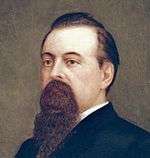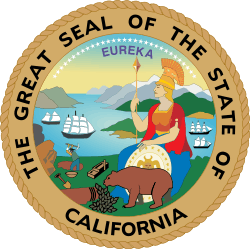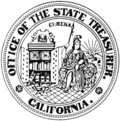Romualdo Pacheco
| Romualdo Pacheco | |
|---|---|
 | |
| 12th Governor of California | |
|
In office February 27, 1875 – December 9, 1875 | |
| Lieutenant | William Irwin (acting) |
| Preceded by | Newton Booth |
| Succeeded by | William Irwin |
| 9th Lieutenant Governor of California | |
|
In office December 8, 1871 – February 27, 1875 | |
| Governor | Newton Booth |
| Preceded by | William Holden |
| Succeeded by |
William Irwin as Acting Lieutenant Governor |
| 9th California State Treasurer | |
|
In office October 10, 1863 – December 7, 1867 | |
| Preceded by | Delos R. Ashley |
| Succeeded by | Antonio F. Coronel |
| Member of the U.S. House of Representatives from California's 4th district | |
|
In office March 4, 1877 – February 7, 1878 | |
| Preceded by | Peter D. Wigginton |
| Succeeded by | Peter D. Wigginton |
|
In office March 4, 1879 – March 3, 1883 | |
| Preceded by | Peter D. Wigginton |
| Succeeded by | Pleasant B. Tully |
| Member of the California Senate | |
|
In office 1857–1863 | |
| Personal details | |
| Born |
José Antonio Romualdo Pacheco, Jr. October 31, 1831 Santa Barbara, Alta California, Mexico |
| Died |
January 23, 1899 (aged 67) Oakland, California, United States |
| Resting place |
Mountain View Cemetery Oakland, California 37°50′07″N 122°14′09″W / 37.8353°N 122.2358°W |
| Political party | Republican |
| Spouse(s) | Mary McIntire |
| Profession | Judge, rancher |
| Religion | Roman Catholicism |
José Antonio Romualdo Pacheco, Jr. (October 31, 1831 – January 23, 1899) was a Californio politician and diplomat. He was elected and appointed to various California state and federal offices and posts throughout his more than thirty-year career, including serving in the California State Senate, as the 12th governor of California, and three terms in the United States House of Representatives. Pacheco remains the only Hispanic or Latino governor in the state's history as part of the U.S. He was also the state's first governor to be born in California and the only governor to be born in the state before statehood.[1] Pacheco represented California in the United States House of Representatives from March 4, 1877 to February 7, 1878, and from March 4, 1879 to March 3, 1883. He was the first Hispanic Representative from a U.S. state; several others had previously served as delegates for U.S. territories and as such did not have full voting privileges.
Early years
José Antonio Romualdo Pacheco, Jr. was a Californio, born in Santa Barbara, California to a prominent Alta California family. His father, Captain José Antonio Romualdo Pacheco, had moved to Alta California from Guanajuato, Mexico in 1825, and served as an aide to Governor José María de Echeandía. Captain Pacheco was killed at the Battle of Cahuenga Pass in 1831, when the young Romualdo was just five weeks old. His mother, Maria Ramona Carrillo de Pacheco, was a sister-in-law of General Mariano Guadalupe Vallejo, and a daughter of Maria Ygnacia Lopez de Carrillo, the grantee of Rancho Cabeza de Santa Rosa. After the death of his father, Romualdo's mother married Captain John D. Wilson, a Scotsman, who sent Pacheco to Honolulu, Hawaii for his education.
At age twelve, Pacheco began an apprenticeship aboard a trading vessel. The Mexican-American War broke out two years later, and he was briefly held by American forces on one trip in July 1846 as he brought cargo to Yerba Buena (which is now San Francisco). The ship he was on was searched, and he made an oath of allegiance to the United States and was released.
Politics

Pacheco's association with a prominent family in the state helped him to gain support as he entered politics in the 1850s. He was also well respected by Anglos coming into the area. Early in his political career in the 1850s, he was a Democrat. He became affiliated with the National Union Party in the 1860s, but was elected to most of his positions as a candidate for the Republican Party.
Pacheco was elected to the state senate in 1857 and re-elected two times, serving until 1863. During the American Civil War Pacheco was appointed the rank of brigadier general by Governor Leland Stanford and directed to disarm military companies in the Los Angeles area that were not loyal to the Union.
Pacheco served as state treasurer from 1863 to 1867, then returned to the State Senate until becoming lieutenant governor. He served as Lieutenant Governor of California under Newton Booth until Booth was elected to the United States Senate in 1875. Pacheco then served as governor from February 27, 1875 to December 9, 1875, when Lieutenant Governor William Irwin, winner in the September elections that year, was inaugurated.
After briefly serving as governor, Pacheco ran for a U.S. House seat, defeating incumbent Peter D. Wigginton by just one vote. Wigginton contested the election, eventually forcing Pacheco to leave in 1878 when the House Committee on Elections refused Pacheco's certificate of election. Returning to California, he went into business until winning a House seat again in September 1879. He was reelected in 1880.
After leaving Congress, Pacheco lived on a cattle ranch in the northern Mexican state of Coahuila for five years until appointed U.S. Minister to Central America in 1890. He returned to California in 1893, and died in Oakland in 1899. He is buried in Oakland's Mountain View Cemetery.
Family life
In 1863 he married Mary McIntire, a 22-year-old playwright. They had two children, Maybella Ramona (b. 1865), and Romualdo, who died in childhood. In 1889 Maybella married Will Tevis, the son of a powerful business family, in San Francisco. Maybella and Will would give Romualdo and Mary Pacheco four grandsons.
See also
References
- ↑ "Romualdo Pacheco 1875 - 1875". Governors of California. 2012. Retrieved 7 February 2012.
External links
- United States Congress. "Romualdo Pacheco (id: P000003)". Biographical Directory of the United States Congress.
- Romualdo Pacheco at the LOC Hispanic Americans in Congress
- Romualdo Pacheco at The Political Graveyard
- Ronald Genini & Richard Hitchman, Romualdo Pacheco: A Californio in Two Eras, The Book Club of California:1985. LC Control#86101529


